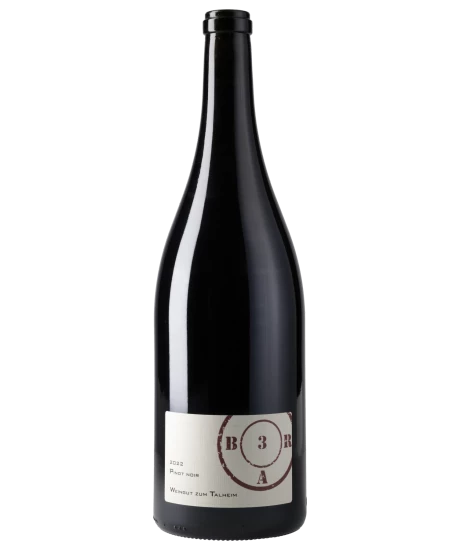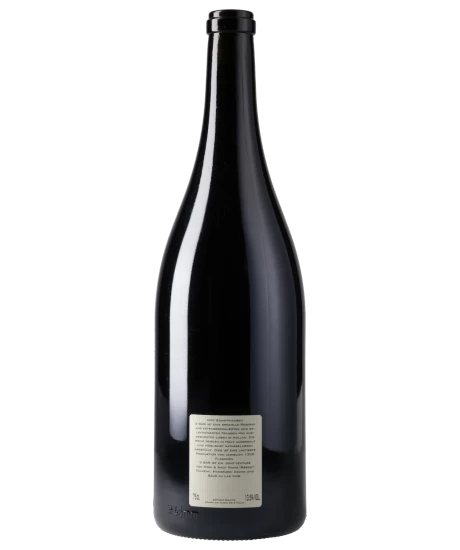3 BAR Pinot Noir 2022
AOC Schaffhausen, Weingut zum Talheim, 1500 ml

A sip of home
- 3 BAR – Three heritage wineries, one vibrant red, a sip of home.
- Ripe strawberry, cassis and milk chocolate on the nose. Smooth, fresh and lightly oaked.
- Perfect with cold cuts, cheese plates or mushroom dishes – or simply for a relaxed end to the day.
Description
Makes an impression: 3 BAR is a joint venture between the Zum Talheim winery in Schaffhausen, the Adank family from the Bündner Herrschaft region and Baur au Lac Vins. Three traditional houses, one lively and uncomplicated red. Aromas of ripe strawberries, cassis, milk chocolate and vanilla. Soft and full-bodied on the palate with freshness and spice. Lightly kissed by wood. Perfect with a ham and cheese platter in front of the fireplace. Or with mushroom dishes, which Pinot Noir pairs with perfectly.
Attributes
| Grape variety: | Pinot noir |
| Producer: | Hansruedi Adank |
| Origin: | Switzerland / Ostschweiz / Schaffhausen |
| Other bottle sizes: | 750 ml |
| Label: | Vegan |
| Ripening potential: | 1 to 6 years |
| Drinking temperature: | 16 to 18 °C |
| Food Pairing: | Roast veal with morel sauce, Calf's kidneys with mustard sauce, Crispy roast chicken, Meat terrine, Spicy hard cheese |
| Vinification: | fully destemmed, short must fermentation |
| Harvest: | hand-picking |
| Maturation: | short cultivation, in used barriques, partly in steel tank |
| Volume: | 13.5 % |
| Note: | Contains sulphites |
Pinot noir
Blueprint of the terroir
No other variety expresses its terroir as precisely as Pinot noir. It is a sensitive, fragile grape. But when it succeeds, it gives the world some of its very greatest wine plants. It especially excels in Burgundy, where it has been cultivated for at least 700 years. Even in the middle ages, it was considered so precious that it was kept separate from other grapes so as to not diminish its value. The finest examples are delicate and fragrant with aromas of cherries and red berries. With maturity, notes of forest floor, leather and truffles enter as well. An irresistible fruity sweetness still shines through, even after several decades. The Pinot noir does well in cool locations: in Switzerland and in Germany, where it is known as Blauburgunder and Spätburgunder respectively; in Alsace and in South Tyrol, in Oregon, New Zealand and Tasmania. Not least, it yields fantastic champagnes. It is a wonderful culinary companion. With its soft tannins and charming bouquet, it meshes with everything, from Güggeli and cheeses to fried fish.

Schaffhausen
Schaffhausen: the elegance of the north
The northernmost vineyards in Switzerland are located in wine-growing villages such as Thayngen and Schleitheim. Nevertheless, the high quality Pinot Noir selections from here show an amazing richness and fruit. To express solidarity with this leading red variety, the wine-growing canton gained the name “Blauburgunderland.” The red variety occupies around 70 percent of the total cultivation area of 500 hectares, where it yields wines of astounding diversity.

Ostschweiz
Eastern Switzerland: an intriguing puzzle
Eastern Switzerland has long been positioned on the northern rim of the climate zone where the cultivation of popular Swiss varieties is possible. Due to a warming climate, the vineyards of Aargau, Zurich, Schaffhausen, Thurgau and Graubünden are now in the zone where varieties such as Müller-Thurgau or Pinot Noir succeed excellently. But even long-established, almost-forgotten varieties such as Elbling, Räuschling and Completer are experiencing a renaissance.

Switzerland
Switzerland – A small country with enormous diversity
Switzerland is famous for its banks, watches, and cheese, but not necessarily for its wine. The Swiss didn't invent wine, but they have been extremely open and curious to it. Wine culture arrived in what is now modern Switzerland via several routes: from Marseilles to Lake Geneva and the Lower Valais region; from the Aosta Valley through the Great St. Bernard Pass to the rest of Valais; from the Rhone through Burgundy, across the Jura Mountains to Lake Constance; and from Lombardy to Ticino, and then on to Grisons.





